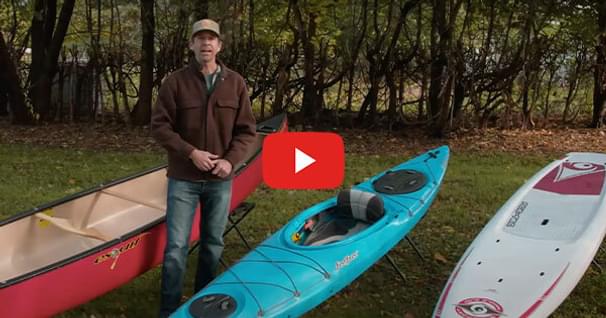Self Test: Touring Kayaks
For purposes of this writing I'm going to define these as closed-deck models over 14 feet in length with built-in flotation fore and aft. They may or may not have a rudder or a skeg to aid in tracking. These boats are made for going somewhere on open water and can be used easily in class I river conditions. This style of kayak has a wide window of use ranging from gentle rivers and lakes on up to multi-week ocean expeditions. When taking a kayak lesson, you will most likely be taught in this type of boat because the skills you learn easily transfer to other types of kayaks. Whitewater kayaking has some exceptions to this, but then, that's another story.
Questions you should ask yourself before you hit the water:
1) Is my boat safe?
- Does it have adequate flotation? Bulkheads and hatches aren't enough if they leak. Test them, be sure all seals are in place and that any fittings or cables that create holes in the deck are leak free.
- Any holes that it wasn't born with? Most holes in kayak hulls are actually fairly easy to repair.
- Are cables and footrests in good working order?
2) Am I dressed for immersion? This is the single most important thing you can do to increase your comfort and safety. See article on dressing for the four seasons for tips on this.
3) Do I have the proper safety equipment?
- Spare paddle
- PFD
- Skirt that fits your boat
- Tow-rig
- Signaling devices: whistle, cell-phone or VHF radio (open water use), flares for open water trips
- Bailing pump
- Drinking water and food: always carry plenty - it can save your life!
- First aid kit
- Flashlight or torch for you BCU folks
- "Crash kit": compact belt pack kit that contains: flashlight, a lighter, repair kit, an exposure bag and an energy bar or two
4) Are my skills appropriate to the conditions that I could encounter today?
- If you don't know the answer to that question, they probably are not.
- In short, you really shouldn't be out farther from shore than you can comfortably swim if can't self-rescue. That may mean a reliable Eskimo roll if you are paddling alone or well-practiced group rescues when you are paddling with friends. Clearly it is safest in numbers, but only if everyone in your group has the skills to cope with the conditions you are paddling in.
5) Crossings. Assuming all of your answers to the above questions were positive: Frankly, you could just about write an entire book on the mental gymnastics one should go through in making a judgement to do a crossing or not. Crossings of over a mile or two really shouldn't be taken on by less than three boaters at a time. So, we need simple and basic questions as weeders for this potentially life threatening decision.
- Am I AND each of my party competent to rescue themselves (reliable Eskimo roll) AND each other? The conditions that you are paddling in should not be over the skill level of anyone in your group. Your "weakest link" determines what you can go out in.
- Do I know how to use all my safety gear? Both a cell-phone and a VHF may be necessary in some areas. Know if a cell-phone will work in an area before you rely on it. Have a back up system like a VHF. Know how to use it. Practice by calling other boaters now and then to ask them what seas they are encountering in places that are out of your view. They can be an important information gathering tool to assist you in decision making, particularly when it comes to questions like "should I stay or should I go?".
- Have I filed a float plan with someone I trust? This should be someone who is looking for your return and has the ability to initiate a search. Its should have your launch point, your return point, date and time, number of people in your party and colors of boats and PFD's. Be sure to leave enough wiggle room in your plans for normal deviations that can occur with weather or exploration. This is also where handheld VHF's and cell-phones are necessary to either call for assistance or simply call the person who knows your float plan and tell them if there is going to be a change. You also don't want to inadvertently initiate a search.
Many readers have added valuable information and comments in the past via e-mail through my web-site. Your comments are valued. Often your additions end up in future articles and may contribute greatly to someone's safety. Thank you.
Related Articles
If you recently started the search for a new kayak then you know there are a lot of factors to…
Ken Whiting answers the big question for new paddlers - Do you go for a canoe, a kayak, or a stand up…
By changing how you edge and balance your boat you can increase your stability and adaptability. Using…
After the raw dimensions of length, width and depth, canoe performance is determined by hull shape.…



